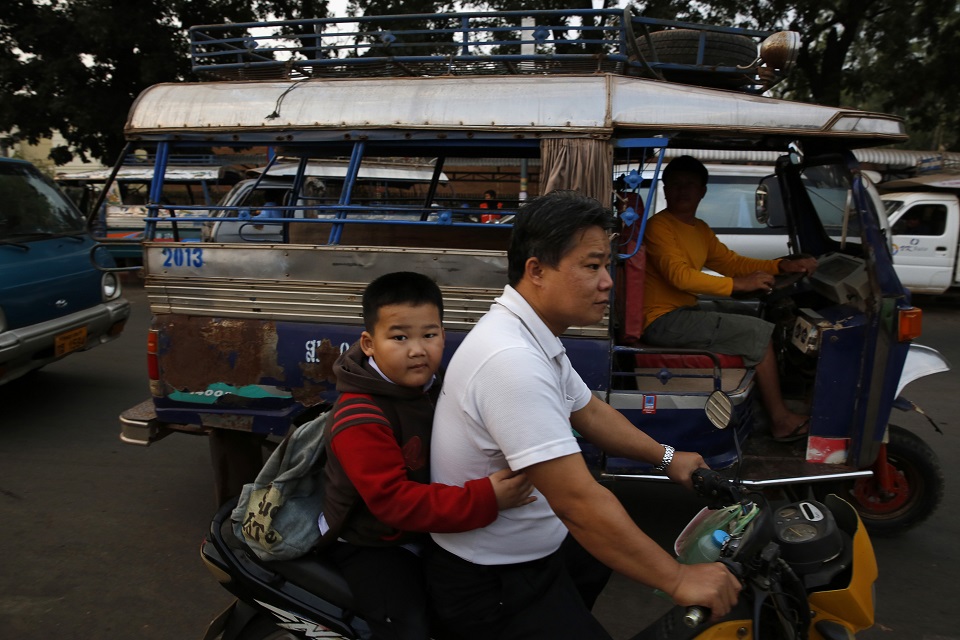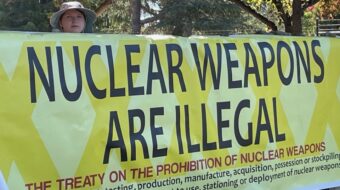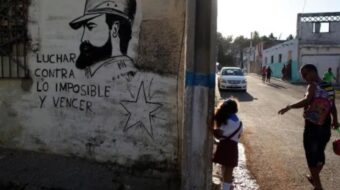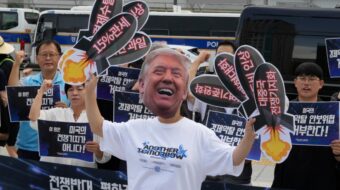
When it comes to countries in Asia building socialism, places like China and Vietnam may come to mind for many people, but not too many think of Laos. Landlocked between Vietnam, Cambodia, Thailand, Myanmar, and China, this mountainous country sits in the center of Southeast Asia and has lived through French and Japanese colonialism, civil war, and years of military attacks by the United States.
During the U.S.’ Indochina War, two million tons of bombs were dropped on Laos, nearly equal to all the bombs dropped in Europe and Asia by the U.S. military during all of World War II—nearly a ton of explosives for every person who lived in Laos at the time.
Since the overthrow of the U.S.-backed monarchy and the establishment of the Lao People’s Democratic Republic in 1975, the people of Laos have been engaged in a long effort to develop their economy and prepare the basis for a modern socialist future.
Michael Christopher, a People’s World correspondent now based in Vientane, the capital city of Laos, produced the following article as an introduction to the revolutionary process in this country and the political economy of Lao socialism.
The National Democratic Revolution
On Dec. 2, 1975, Laos’ U.S.-backed King Sisavang Vatthana formally abdicated the throne, much to the dismay, though not the surprise, of his allies in Washington. With the fall of Phnom Penh in Kampuchea (Cambodia) and Saigon in southern Vietnam earlier that year, anti-monarchist protests swept Laos as well. The grassroots resistance forces of the Pathet Lao—the Lao People’s Liberation Army—entered Vientiane, peacefully, but armed. The king understood what the future would bring if he attempted to maintain power, and instead, he voluntarily ended his 16-year reign.
With the stroke of a pen, more than 20 years of struggle and war against colonialism, imperialism, and exploitation, were finally over. Political power was formally handed over without bloodshed to the Lao People’s Revolutionary Party (LPRP). As the red, white, and blue flag of the free Lao nation was hoisted over the capital of Vientiane alongside the scarlet banner of socialism, the Lao People’s Democratic Republic (Lao PDR) was born.

The young Lao PDR inherited what many would have considered an untenable set of circumstances: Around 10% of the Lao population had been killed as a direct result of the French colonialist and U.S. imperialist wars; a further 20% had been injured or permanently disabled; around 10% had become refugees abroad; and at least 50% had been displaced from their home villages in some form. Life expectancy was just under 46 years old, literacy was below 25%, and millions of unexploded American bombs littered the countryside.
As a result of the exploitation of the colonial period, productive capacity in the country was nearly nonexistent; what little was left in the way of infrastructure was largely damaged or destroyed in the wars of liberation—the struggle against French colonialism, and the “secret war” waged against Laos by U.S. imperialism.
During the Communist Party of China’s early period in the revolutionary struggle in that country, there was a debate between members who believed China’s lack of productive capacity required a period of capitalism first in order to establish the productive base necessary for socialism, and those who advocated an adapted approach: Rather than relying primarily on industrial workers as the leading force, as Russian revolutionaries had, a greater alliance of workers and peasants would be necessary.
Nearly two decades later, of the 19 representatives recorded as attending the first congress of the Lao People’s Party (now the LPRP) in Houaphan province, only two were recorded as being workers, with 13 recorded as peasants, and the remaining four being from the “petty bourgeois” class. So, observing the material reality of their nation and following the approach of the Communist Parties of China and Vietnam, the LPR determined it was necessary to rely on a worker-peasant alliance.
On this question, there was really little debate to be had. Whereas China and Vietnam at least had small industrial bases, Laos had virtually none. The distinct characteristics of the Lao economy—rural conditions dominated by agricultural workers—shaped policy development following the founding of the Lao PDR.
The Three Revolutionary Campaigns
I: The Revolution of Productive Forces
After 1975, the LPRP and its General Secretary, Kaysone Phomvihane, led further revolutionary programs in all areas of Lao society: the productive forces, the scientific-technical revolution, and the ideological-cultural revolution. Beginning in 1979, a reassessment of Lao economic realities began to be developed which would reach its climax at the party congress in 1986.
Formally known as the New Economic Mechanism (NEM), the reforms of this period were modeled after the New Economic Policy (NEP) formulated by V.I. Lenin in the Soviet Union in the 1920s, as well as utilizing lessons learned from the experiences in neighboring Cambodia, China, and Vietnam.
The LPRP accepted the economic reality that advanced socialism could not be constructed on a pre-industrial base. It was necessary to develop the nation’s industrial capacity, moving away from a wartime footing and towards a productive market-based economy capable of uplifting the whole Lao nation. In his 2015 book, The Party and People of Laos Choose and Adhere to Socialism, Mounkeo Oraboun, a former government minister wrote:
“[T]he economy in the democratic regime of the Lao people is a commodity economy with many parts operating according to the ‘market mechanism with state management,’ which is the correct view and appropriate to the actual conditions of Laos.”
This revolution of productive forces combined the establishment of state-owned enterprises and increased emphasis on the development of local infrastructure with the development of new agricultural and social policies.
As mentioned above, at least 50% of the Lao population had been displaced in some form during the war. And with a population of only around three million people in 1975 but a total land area of around 236,800 square kilometers, Laos had a population density of only around 12.6/sq. km. This meant that the Lao PDR had an altogether unique opportunity in terms of resettling its population and carrying out widespread agrarian reforms.
With vast amounts of sparsely populated territory, the government was able to resettle whole villages in new areas with land more suitable for agricultural cultivation and industrial development. For communities such as the Khmu and other so-called “hill tribes” that had migrated to the region very recently and settled in the most inhospitable areas high in the mountains, this meant moving to the lowlands where the soil was more suited for farming.

Opposite to the disastrous “emptying of the cities” carried out by the Pol Pot regime in Kampuchea, the LPRP actively encouraged the development of larger population centers and the coalescing of villages, resulting in many cities and towns across the Lao PDR only coming into existence after 1975. This made it easier to develop infrastructure projects; rather than attempting to reach isolated communities high in the mountains, they could more easily bring those communities to the lower areas, create easier access via the construction of roads, and in that way vastly improve the livelihoods of the people through the introduction of healthcare, education, centralized administration, and so on.
II: The Scientific-Technical Revolution
In applying the principles of Marxism-Leninism to postwar conditions, the LPRP initiated developments in Laos that would have seemed wholly impossible five decades ago. In effect, the LPRP succeeded in transforming the nation from an oppressed feudal-colonial nation into a developing socialist state without a period of full-fledged capitalism.
The population has more than doubled, to nearly seven-and-a-half million, increasing density to around 31.3/sq. km. The recovery of the population and its urban densification is an indicator of development, but it is by no means the only one. While education is not yet free for all Lao people, the national literacy rate has exploded from less than 25% in 1975 to 87.1% as of 2015—meaning that literacy in Laos has matched or even surpassed the United States, depending on the statistical source one consults.
True to its foundations, the LPRP seeks to improve education and encourage building up the Lao working class into professionals with a strong knowledge base and highly developed skill sets. The first step in this scientific-technical revolution has been to maximize access to education, vastly improve literacy, and begin the process of attracting a return of knowledgeable professionals from the Lao diaspora while simultaneously developing the first generations of new Lao workers at home.
According to a survey conducted by the Japan International Cooperation Agency (JICA) in 2016, the Lao PDR is home to five central hospitals, 17 provincial hospitals, 134 district hospitals, and 983 health centers, totaling around 1,139 facilities, or one health facility per 6,000 or so people. Even more facilities have been constructed since the survey was conducted. By contrast, the U.S. boasts around one facility per 50,000 or so people.
While the state issues an insurance program, defraying healthcare costs for many people, and access has been expanded since the founding of the Lao PDR, the quality of care and remaining costs continue to be a focus of ongoing policy reforms and development. Likewise, due to the resettlement programs following the war, the remaining areas with lower access are largely those communities who chose to remain in more difficult-to-access areas in the mountains or chose to return to the mountains rather than remain in new settlements.
As for the reliance on foreign aid, according to one research paper published by the Mekong Institute in 2014, Official Development Assistance (ODA) accounted for only around 4% of Lao GDP between fiscal years 2000-01 and 2008-09. This was utilized primarily to cover funding gaps in government-led programs around agricultural development, health, and education. The share of GDP represented by ODA has declined as Lao socio-economic development continues, indicating the overall development of the nation and its growing self-sufficiency.
And the costs of war continue to suck up national resources. A portion of foreign aid, for instance, is still allocated every year towards the deactivation and removal of unexploded ordnance (UXO) dropped by the U.S. during the war; in total, around 8,000 sq. km. of the country remains contaminated by UXO.
III: The Ideological-Cultural Revolution
The Phra Lak Phra Ram, the traditional Lao adaptation of the Ramayana—the story of a Bodhisattva named Rama, one of the previous lives of Gautama Buddha—is considered the mythical origin story of the Lao nation. While it is likely that Buddhism arrived in the region earlier, local legend holds that the great story was brought to Laos by King Fa Ngum, who established the first Lao kingdom of Lan Xang in the 14th century.

The Buddhist religion has, and remains, the overwhelming majority within Laos, with each village (roughly equivalent to a neighborhood) hosting at least one Wat or temple. However, so-called Buddhist nationalism as has emerged in neighboring Myanmar is not present, and the Marxist LPRP maintains a policy of religious harmony rather than forced atheism.
Traditional Buddhist and animistic religious and cultural practices exist so closely alongside one another that they often intersect, such as in the prevalence of so-called “spirit houses.” These small house-shaped shrines placed atop pedestals are believed to attract good spirits who will ward away bad ones. They’re so popular that even many Buddhist temples and most family homes have them.
Rather than atheistic persecution, as is often incorrectly associated with socialist governance, the LPRP maintains a policy of religious freedom and actively encourages the robust flourishing of religious and cultural diversity within the nation. No greater example of this exists than the reconstruction of Hai Hin Mixayaram in Phonsavan. The site was destroyed by U.S. bombs during the war and was rebuilt thanks to cooperation between local Buddhist and party authorities.
Following the temple’s reconstruction, in 2015 the Huge Buddha of Hai Hin Mixayaram was then added to the temple, looking out over the city of Phonsavan and the Xiengkhouang plateau. It symbolizes a promise of protection and prosperity and the determination to never allow the indiscriminate terror of war to hurt the people again.
At its core, the Lao ideological-cultural revolution is the social reflection of developments in the Lao political economy. As the building of socialism brings common prosperity, so too does it bring equality for people, regardless of gender, ethnic group, or religious affiliation.
Being a predominantly agrarian society—agriculture still represents 51% of the Lao PDR’s GDP, and nearly 80% of the population is engaged in farming—Lao traditional culture remains strongly oriented around one’s family and village. In colonial times, this meant unequal rights between men and women, enmity between the various tribes and ethnic groups, and so on. Today, the Constitution of the Lao PDR guarantees religious freedom and equality for all people, regardless of gender or ethnic origin.
By maintaining the closest relationship possible between the government and the people, developing a people’s democracy that is direct and responsive to the interests of the entire society, the LPRP continues to strengthen its direct relationship with the public. As in neighboring China and Vietnam, anti-corruption campaigns and efforts to further ensure the broadest possible representation of all people within the democratic system have been a major focus of recent policy reforms.
Laos looks to the future
Xiengkhouang province perhaps best represents the cumulative progress and development resulting from these individual policies and the ongoing development of Laos. As mentioned in previous reporting on the Lao PDR, Xiengkhouang province and its geographically vital plateau were host to some of the fiercest combat between pro-independence Pathet Lao forces and the U.S.-backed Royal Lao Army.
By 1975, much of the province, including its ancient capital, Khoune, lay in total ruin, with massive bomb craters and UXO scattering the once-prosperous landscape. Nearly all pre-war inhabitants of Xiengkhouang were evacuated over the course of the war in order to avoid indiscriminate bombing. As UXO-clearing and reconstruction began after the war, government-led resettlement brought many families back, as well as introducing many more.
Today, the new capital of Xiengkhouang province is the city of Phonsavan, established after the war. Deactivated UXO are a common sight, used for everything from decoration to construction, and the highly diverse population of the area includes a sizeable Hmong community.

The Hmong people, being one of the “hill tribes,” traditionally live high in the mountains. Their numbers are so sizeable that thousands of Hmong people come to Phonsavan from around the world in order to celebrate Hmong New Year, one of the most important events in the Hmong culture.
Near the center of the city stands an agricultural co-op, while all around it the land is put to cultivation. The inhabitants of one village visited by People’s World, Ban Na Pia, near Plain of Jars Site 3, are traditionally farmers, but they’ve also developed a unique handicraft industry of their own—melting down UXO and turning them into various trinkets for sale. This has earned their locale the nickname “spoon village.” The city’s nearly 40,000 inhabitants are serviced by four hospitals and countless smaller clinics.
The Lao PDR, as a developing nation, still has a long road ahead in its pursuit of socialism. However, by pursuing socialism without entering a period of full capitalism, building the socialist-oriented New Economic Mechanism, and continuing the development of economic reforms on the basis of Marxism-Leninism, the Lao PDR, with the LPRP at the helm, has accomplished more in the past five decades than would have seemed possible in 1975.
We hope you appreciated this article. Before you go, please support great working-class and pro-people journalism by donating to People’s World.
We are not neutral. Our mission is to be a voice for truth, democracy, the environment, and socialism. We believe in people before profits. So, we take sides. Yours!
We are part of the pro-democracy media contesting the vast right-wing media propaganda ecosystem brainwashing tens of millions and putting democracy at risk.
Our journalism is free of corporate influence and paywalls because we are totally reader supported. At People’s World, we believe news and information should be free and accessible to all.
But we need your help. It takes money—a lot of it—to produce and cover unique stories you see in our pages. Only you, our readers and supporters, make this possible. If you enjoy reading People’s World and the stories we bring you, support our work by donating or becoming a monthly sustainer today.










